Dimmable LED bulbs: selection tips, an overview of the best manufacturers
Until recently, the choice of a light bulb was simple and unpretentious. It was enough to tell the seller the desired power, and you received a device that shone brightly and consumed a lot of energy, or shone worse, but it was a bit more economical.
Now, in order to choose the right dimmable LED lamps, you need to have at least a minimum of knowledge - there are a lot of characteristics that affect their operation. In this article, we will deal with the main ones, so that you can understand the technical parameters indicated on the package and their meaning. That will allow you to choose the appropriate bulb option.
The content of the article:
- What is a dimmable LED lamp?
- The principle of the dimmer
- Pros of using a dimmer for LED devices
- Criteria for choosing a high-quality dimmable lamp
- No. 1 - the shape of the lamp and its effect on lighting
- No. 2 - flickering of light and methods for its detection
- No. 3 - device power and operating voltage
- No. 4 - luminous flux and dimming limits
- No. 5 - color temperature and color rendering
- No. 6 - base and housing of the device
- No. 7 - device service life
- The best manufacturers in the lighting market
- Conclusions and useful video on the topic
what such dimmable LED–lamp?
This device is equipped with a block with a PWM function, i.e. pulse width modulation capabilities. The unit has in its design a specific circuit that allows you to recognize the adjustment. It controls the stabilizer, which is located in the housing and changes the brightness of the lighting.
Conventional energy-saving light bulbs cannot be switched on via a dimmer - these two devices are incompatible. The conflict manifests itself in a blinking or weak glow of the device in the off state. About others reasons for blinking LED lamps we talked about here.
And since LED or fluorescent lamps are designed for a certain number of cycles of activating the light source and turning it off, they burn out with this use in a month or two.
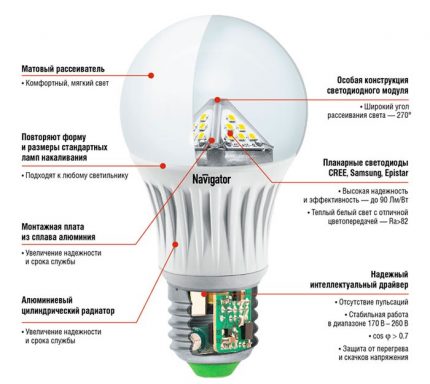
The fact is that inside the energy-saving lamps there is a capacitor (electronic converter), to which a certain amount of current flows even when turned off.
The capacitor, gaining the necessary charge, feeds the diode, and it flashes from time to time, despite the off state.
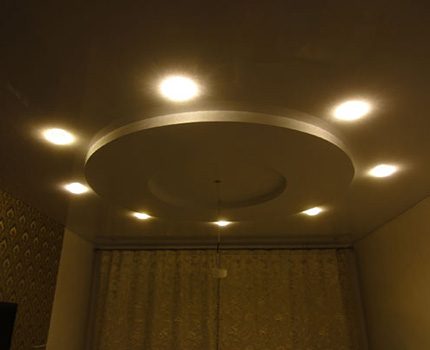
The principle of the dimmer
Dimmers allow you to change the intensity of artificial lighting. Electric power regulation in dimmer occurs due to a change in voltage in the rheostat or transformer. For diode lamps produce special dimming devices.
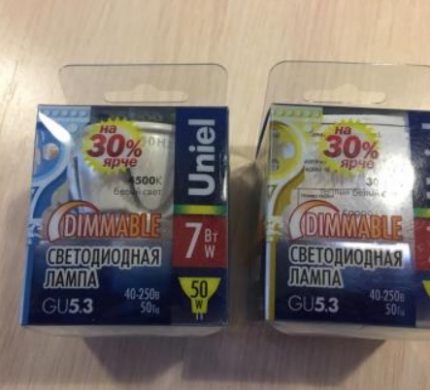
Dimming lamps are sometimes poorly combined with some models of dimmers. This is manifested in a sharp change in brightness when adjusting or in extraneous noise - hum, cod.
Sometimes a device conflict manifests itself in the flashing at full power of all LED lamps in the chandelier, immediately after switching on. Solving the problem can replace one of them with an incandescent lamp.
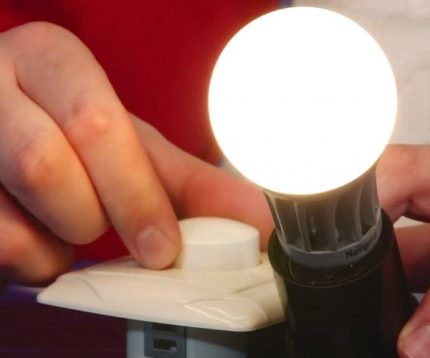
Pros of using a dimmer for LED devices
A significant plus of using a dimmer is the ability to not only save energy, but also create a unique atmosphere with dim light. Or it’s advantageous to highlight a specific area of the room by highlighting it led stripcontrolled by a dimmer.
Conventional LED lamps cannot be used with dimmers. Their brightness will not change when scrolling the knob. The device will only turn on when sufficient voltage is reached at full brightness.
This is due to the fact that the driver compensates for the ongoing voltage fluctuation to the normal operating current of the LED. But in the design of LED dimmable lamps there is a special driver, thanks to which it becomes possible to control the brightness.
Advantages of LED devices:
- profitability - consume energy 90% less than incandescent lamps;
- lack of UV and IR radiation;
- long service life of the device - up to 30,000 hours;
- Warranty period 36 months;
- high color rendering index.
A large warranty period allows you to pay back the high cost. Out-of-date dimmable LED lamps are replaced at the outlets with new ones, thus achieving even greater savings.
Criteria for choosing a high-quality dimmable lamp
The many technical characteristics that we see on the packaging, manufacturers indicate for a reason - they are all significant criteria for evaluating the device. How to choose a dimmed LED lamp so that it works flawlessly, we will describe further.
No. 1 - the shape of the lamp and its effect on lighting
By choosing the correct shape of the lamp, you can achieve the desired effect in the room - to illuminate the entire room evenly, focus on a specific work area, create a narrow beam of light.
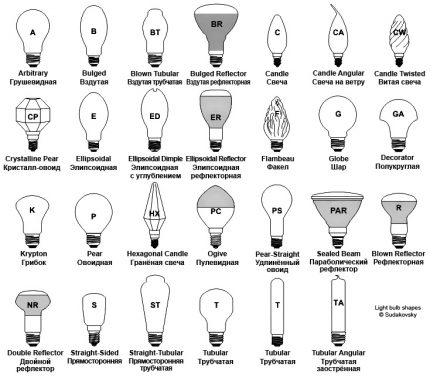
They are as follows:
- Pear-shaped. The bulb is the same diameter as the body, so it only shines forward. Installed in a chandelier or a luminaire whose shades are directed downward, it does not illuminate the ceiling and round shadows form on it.
- In the shape of a familiar incandescent bulb. Designed for traditional use, lighting angle up to 240 °.
- In the form of a candle or a balland. This form was created more like a decorative one, the lighting angle is quite wide - from 240 ° to 360 °. They are used in open chandeliers, floor lamps, sconces, etc.
- Reflex type. It is used in shops, beauty salons, boutiques, it is used in floodlight type lamps.Narrows the luminous flux, spotlighting a specific area.
- Point (accent). Used for spotlights that are installed in various designs - suspended and suspended ceilings, in the cabinet or base of furniture. They do not emit heat, so they can be used almost anywhere. But unlike halogen bulbs, which have an angle of illumination of 30 °, they give light with an angle of light flux of about 100 °, so they are a little blind. Narrow-beam models are less common.
To ensure a pleasant, even light, the flask is made of frosted glass. From the inside it is covered with a special coating, which can have different light transmittance. They also produce products with a transparent flask.
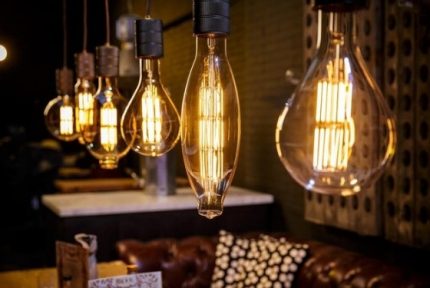
No. 2 - flickering of light and methods for its detection
This phenomenon is characteristic of LED and fluorescent lighting devices. Ripple causes a feeling of fatigue, discomfort, negatively affects the condition of the eyes. A fixture that has a strong flicker cannot be used for living quarters. This phenomenon is especially pronounced in low-quality cheap models.
You can check for flicker visually:
- If you look from one object to another, a stroboscopic effect is created, and for a split second, instead of one object, the human eye sees several.
- Taking the tip of a felt-tip pen or pencil, they quickly move them like a pendulum. If the distinct contours of the subject are not visible, then the flicker is weak and imperceptible to human eyes. If it seems that there are several pencils, then the ripple is high.
- You can also determine the strength of flickering using a smartphone: looking at the light source through the device’s camera, you can see the stripes, which will be brighter the stronger the ripple.
It is fundamentally impossible to completely eliminate flickering in the device, since this phenomenon is characteristic of its operation.
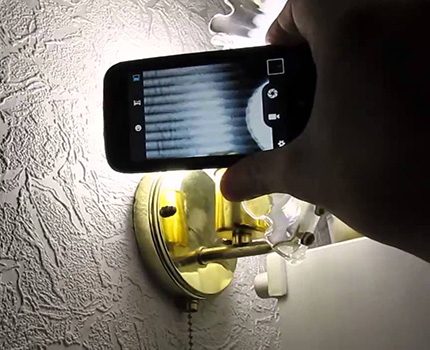
No. 3 - device power and operating voltage
LED lamps manufacturers produce power from 1 to 25 watts. According to tradition, users use, as an equivalent, the power of incandescent bulbs to evaluate their luminous flux.
Usually, the power indicators of LED and incandescent lamps are correlated as 1 to 10-8. That is, a 10-12 W diode lamp is similar to a traditional 75 W bulb in terms of electricity consumption and light output. We talked more about the power of LED bulbs in this article.
Standard for most dimmable LED lamps, class A, with the improvement of technology, has ceased to be the highest. There are devices with class A + and A ++, which consume energy in much smaller quantities.
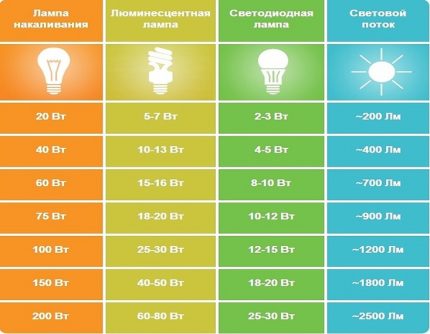
As for the operating voltage, it in the power supply system can be quite different from the standard 220 V. It is especially often observed in suburban power grids.
Power surges can damage expensive dimmable LED lamps. Therefore, it is better to purchase models with a wide input voltage range, which can operate from 170 to 250 V. The ability to connect dimmable LED lamps to a network with a particular voltage depends on the characteristics of the power supply.
No. 4 - luminous flux and dimming limits
The minimum level to which you can reduce the brightness of a dimmed LED lamp is 10%. Models from different manufacturers can act differently and have their own minimum, reducing the brightness to 5.10 or 25%.
When testing their work with different dimmers, device compatibility may affect the result. Diode illuminators shine quite strongly even at 10% brightness. Therefore, it is better to choose models with the lowest possible on-off level.
As for brightness, the ratio of power and brightness in LED lamps does not always reflect the real picture. Therefore, it became necessary to indicate the indicator of the luminous flux (Lumen). It can range from 200 to 2,500 lm.
But LED LED lamps have a significant drawback - the longer they work, the more they lose their brightness, and therefore their effectiveness. In the first 3,000 thousand hours of operation, the brightness drops by 5% and then continues to decrease more actively, decreasing to 50% of the initial value.
The efficiency of an LED lamp, including a dimmable one, can be calculated by dividing the value of the luminous flux by an indicator that displays energy consumption. For different models, the result can vary significantly - from 40 to 100 lm / W.
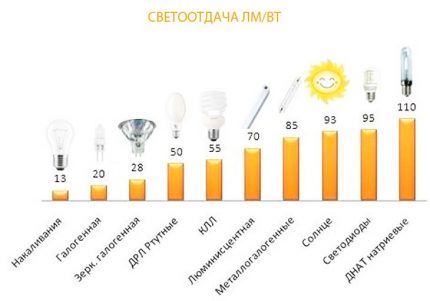
No. 5 - color temperature and color rendering
The color temperature indicator characterizes the light source in terms of its spectral composition, measured on the Kelvin scale. For most types of premises, values of 4,000-4,500 K are considered normal.
But it is better to choose warm light for a house or apartment, with values of 2 700-3 500 K, and for reading or lighting a workplace colder tones are suitable - 4 000-4 500 K. Often the color temperature does not correspond to that indicated on the package and instead of 2 700 You can get a device with a color temperature of 3,000 K.
In more detail, the question of choosing a light bulb with an optimal indicator of color temperature, we lit up here.
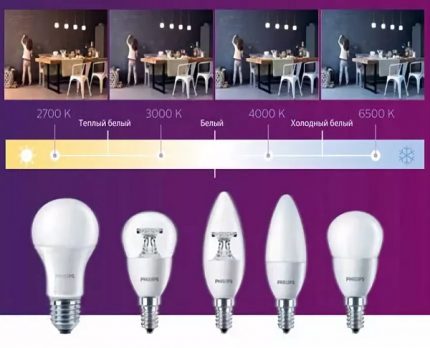
Color Rendering Index (CRI or Ra) Is an important characteristic indicating the level of correspondence of the visible color of an object when it is artificially illuminated to its real color. That is, it shows how natural things look, estimates the level of transmission of 8 colors.
LED index value can be up to 90 Ra (highest, 100 Ra - by the sun).
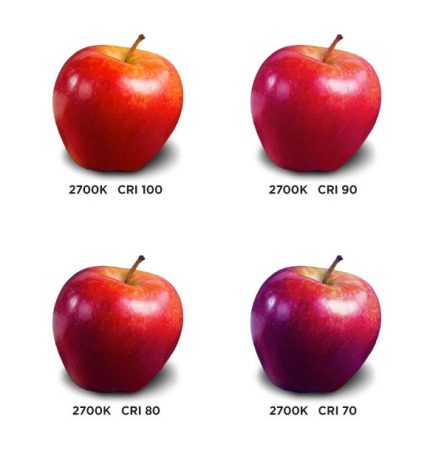
The CRI index is actively used by manufacturers, although it is not quite suitable for measuring color rendition parameters for lighting devices that have white LEDs.
Later, more advanced testing methods were developed that evaluate the quality of light by 15, by 99 colors. A good lamp, if tested additionally, will have high rates in all three indices.
No. 6 - base and housing of the device
Commonly used plinths E27 and E14 (27 and 14 - base diameter in millimeters) have a standard threaded connection. LED lamp with socket E14 ("Minion") is used in sconces, floor lamps, open fixtures, and with a base E27 is used for closed chandeliers and lamps.
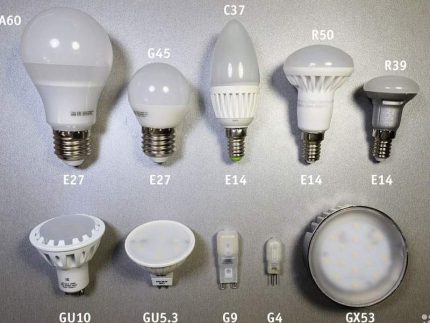
In the new models of illuminators from different manufacturers, dimmable lamps with a base with ventilation ducts have appeared. They contribute to better heat dissipation from the inside of the lamp and diodes, and thereby increase their operating time.
More information on the main parameters and marking of the LED lamp bases in the next article.
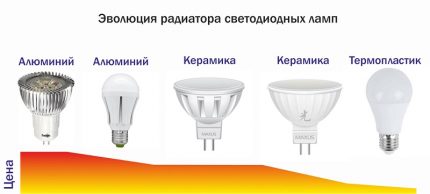
No. 7 - device service life
Operating time depends on the manufacturing quality of the LED lamp with dimmable functions, as well as the conditions of use, and can range from 15,000 to 40,000 thousand hours, provided that it is used correctly. Lamps with base ventilation last longer.
But in fact, the effective life is much shorter. The cause of burnout or malfunctioning may be the poor condition of the electrical network, poor production, factory defects. In addition, over time, light output decreases and the LED lamp sometimes has to be replaced before it breaks down.
High temperatures that are created when the lighting device is installed in suspended ceilings, in luminaires and chandeliers with closed shades also reduce operating time. This is due to overheating of the LEDs, which quickly burn out at high temperatures.
Too low temperature can also negatively affect the service life, worsening the technical parameters of transistors, capacitors. Reduces service life and high air humidity at which conductors are oxidized.
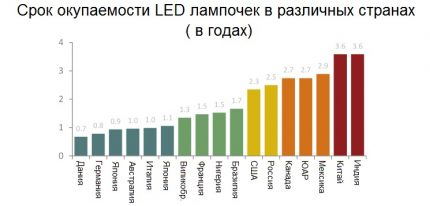
To achieve the replacement of an LED lamp that has burned out or has started to malfunction, you must save proof of purchase. And since commodity checks fade over time, it is best to ask the seller to fill out the device passport.
The best manufacturers in the lighting market
Not all manufacturers make dimmable LED lamps, and their range is not very wide. But those that exist are still enough, because the popularity of adjustable lighting has not yet gained full strength.
Uniel Diode Lamps
Uniel manufactures dimmable LED lamps as part of the Cristal Dimmable and Palazzo Dimmable series. Devices of both series can be used with dimmers designed for standard incandescent bulbs. CRI index is ≥ 80Ra. Brightness adjustment is carried out within 10-100%.
The range of input voltage values at which the illuminators can operate is quite wide - from 40 to 250 V. The bulb of devices is matte.
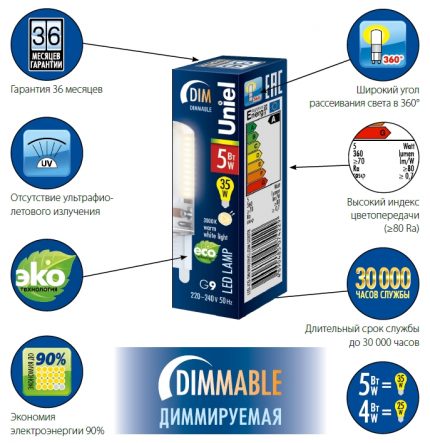
Products from the Cristal Dimmable range have a traditional aluminum alloy casing with an E14 base. LEDs are located in the bulb on the metal petals and create a wide angle of transmission of the light flux - 360 °.
Instruments of the Palazzo Dimmable series are available with a unique shape housing, which has four channels for ventilation. They provide additional ventilation to internal structural elements, prolonging the life of the device.
They are made for fixtures of reflex and spot light, as well as in the form of Ilyich’s bulbs, candles, balls. The types of base used for the production of dimmable illuminators are GU10, GU5,3, E14, E27. The light flux intensity is 500–600 lm, and the power is from 5 to 7 W. The luminous flux is somewhat narrower than that of the previous series - 240 °.
Wide range of Philips LED bulbs
As part of the MASTER series, the Philips manufacturer produces dimmed LED lamps of pear and spherical shape in the form of candles. The range also includes dimmable reflex (Master LEDspot) and accent lamps (Master MV).
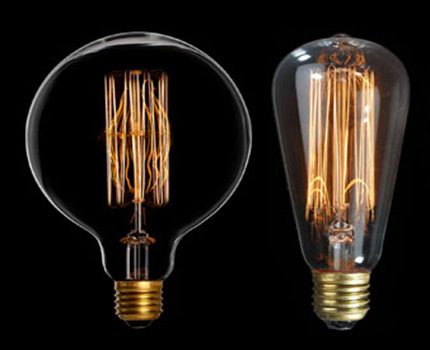
If, when dimming a conventional LED-type lamp, the light remains cold after a decrease in intensity, then with the DimTone function, the lighting becomes warmer with a decrease in brightness. The same effect is observed when dimming halogen light sources and traditional incandescent lamps. The indicated function is used in some models of the MASTER series.
AirFlux technology offers a hidden ventilation system in which dimmable LED lamps last longer - up to 40,000 hours. It is used only in some models of the Master LV series.
In terms of energy efficiency, Philips products are divided into classes from A to A ++. The most economical devices are produced under the names Master MV Value, LEDclassic.
Another article in our article provides more detailed information on varieties. Philips LED bulbs, their pros and cons.
LED Products from Gauss
Gauss produces a fairly wide range of lighting equipment, including dimmable lamps. The products are distinguished by a wide plug of the input operating voltage of 185-265 V, high index Ra>90.
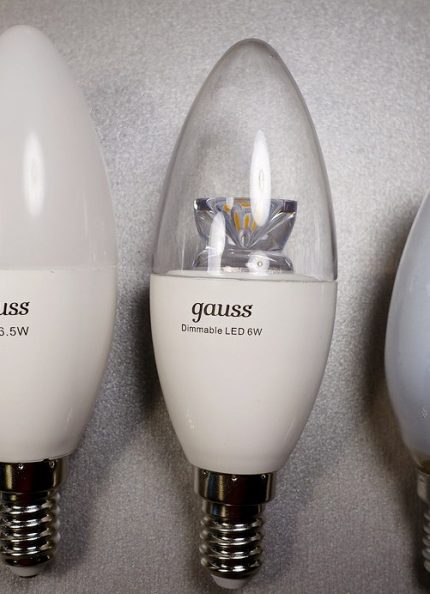
Dimmable lamps are available in the following types:
- Filament. These are devices in the form of a candle and a ball, with a power of 5 watts. The luminous flux values are 420 and 450 lm. The warranty is provided for 3 years.
- Soffit. They are produced with a GU5.3, GU10 cap, with a power of 5 W, a light flux of 500 and 530 lm. Product Warranty - 3 years.
- Capsule. They have a G9 base, the light flux is from 280 to 300 lm, power 3 watts. Warranty period is 1 year.
We recommend that you familiarize yourself with device specifics Gauss bulbs, their technical characteristics, as well as pluses and minuses according to owners reviews.
Separately, it should be said about the lamps with the step dimming function of the Gauss Step Dimmer series. They have a completely different principle of operation and they can not be attributed to classic dimmable lamps.
They are not suitable for connection to a dimmer, as they are equipped with elements already integrated in the base for adjusting the brightness. That is, their work is not combined with dimmers. They can work in electric networks with voltage standards of 180 - 240 V.
They are produced in the form of a ball, candle, in the form of an incandescent lamp, with a declared power of 10 and 7 W, in two values of color temperature - 4,100 and 2,700 K. Due to improved technical characteristics, the warranty period is 3 years.
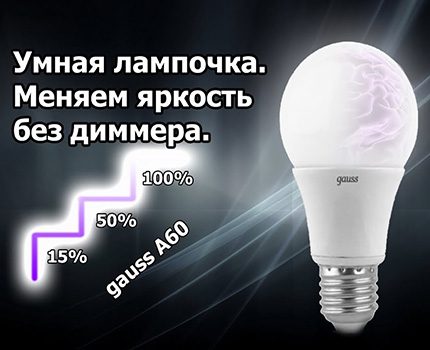
The device is controlled using a conventional switch, and the adjustment is performed step by step, changing the brightness from 15% to 50% and 100%. Each switch switching changes the brightness of light in three stages, the fourth stage - switching off.
Conclusions and useful video on the topic
Connecting different types of lamps to a dimmer:
Overview of dimmable LED lamps:
The production and use of dimmed LED lamps is actively gaining momentum. Until recently, LED lighting devices were incompatible with dimmers. And now sometimes you can observe a conflict in the interaction of devices. Therefore, when buying, you must carefully choose the manufacturer and model.
You want to replace the existing bulbs with dimmed ones, but doubt the correctness of your choice? Ask your questions in the block under the article - our experts and other visitors to the site will share with you their experience in using products of a particular brand.

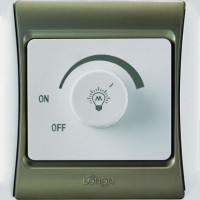 Light switch with dimmer: device, selection criteria and manufacturers review
Light switch with dimmer: device, selection criteria and manufacturers review 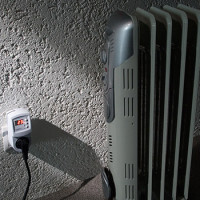 Thermostat in the socket for domestic heaters: types, device, selection tips
Thermostat in the socket for domestic heaters: types, device, selection tips 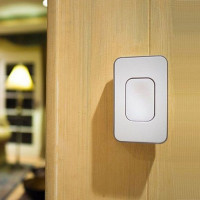 Wireless light switch: selection criteria + review of the best models
Wireless light switch: selection criteria + review of the best models 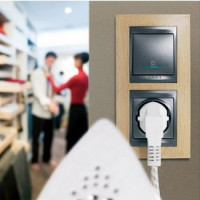 How to choose sockets and switches: an overview of the best brands in today's market
How to choose sockets and switches: an overview of the best brands in today's market 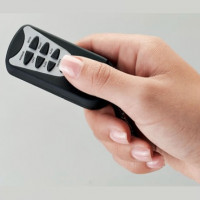 Light switch with remote control: types + overview of TOP brands
Light switch with remote control: types + overview of TOP brands  How to connect a double switch to two bulbs: schemes + connection tips
How to connect a double switch to two bulbs: schemes + connection tips  How much does it cost to connect gas to a private house: the price of organizing gas supply
How much does it cost to connect gas to a private house: the price of organizing gas supply  The best washing machines with dryer: model rating and customer tips
The best washing machines with dryer: model rating and customer tips  What is the color temperature of light and the nuances of choosing the temperature of the lamps to suit your needs
What is the color temperature of light and the nuances of choosing the temperature of the lamps to suit your needs  Replacement of a geyser in an apartment: replacement paperwork + basic norms and requirements
Replacement of a geyser in an apartment: replacement paperwork + basic norms and requirements
Recently, I began to change all ordinary incandescent bulbs to LED ones. Since their energy consumption is several times less, and light output is 7-10 times more. One 10W LED lamp can replace a 75W incandescent lamp. When choosing lamps, it is worth paying attention to the quality of plastic and air cooling, although the LED lamp itself is practically not heated compared to the incandescent filament in old bulbs.
He was visiting a colleague at work, he has a dimmer with LED lamps. Now I want to put myself the same. We have a small child, the function of turning on the light not fully will be very useful. True, I just found out that not all LED lamps work with a dimmer. Back to incandescent lamps is not an option to return - progress does not stand still. We will pick up.
Everywhere there is a lot of discussion about which light is better cold or warm. I don't like either one. Why do manufacturers rarely make lamps with two or even several groups of LEDs with different color temperatures? It seems to me that the spectrum of light would be wider, and therefore closer, if not with the sun, then to halogen lamps or at least incandescent lamps.
I bought on aliexpress light bulbs in which half of the LEDs are “warm” and half are “cold”. The light is much nicer. By the way, these bulbs have three modes: the first time you turn on only “warm” LEDs, the second time - only “cold”, the third time both groups. Although this is not in the description. Cool, but for me it's more of a drawback. It would be better if they were dimmable.
As far as I know, it is far from news that there are LED lamps that give both cold and warm light. In particular, such bulbs are now sold by the manufacturer Philips, the color temperature of which can be adjusted from 2200 K (candle) to 6500 K (bright white light). But these lamps are not dimmable, so if this is the main factor, you will have to cheat a little.
If you want dimmable lamps and at the same time adjust the color temperature, you can find a solution: mount cold and warm lighting lamps and turn them on separately, depending on the situation. I think that this is the best option if you need to adjust the brightness and color temperature in the room at the same time.